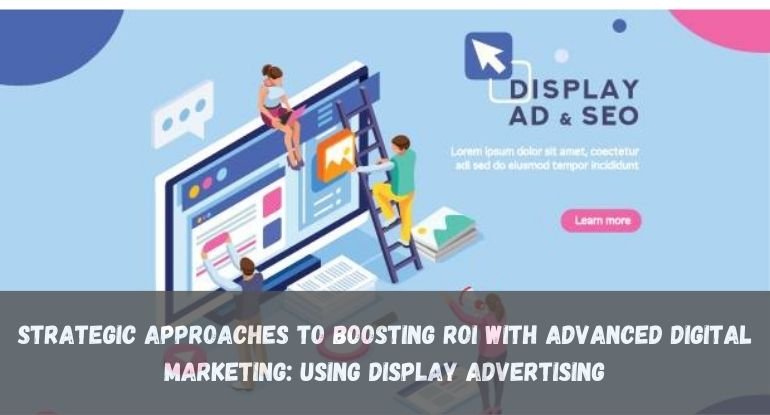Display advertising remains a powerful tool to reach and engage your target audience at any time and in any direction in the digital marketing landscape that is rapidly evolving.
However, it’s important to implement these practical strategies to leverage the power of display advertising to dramatically increase your return on investment (ROI). In this article, we’ll look at strategic approaches to effectively improve display advertising ROI while highlighting valuable insights gained from digital marketing ad copy.
WHAT IS DISPLAY ADVERTISING? HOW ARE THEY USED TO ACHIEVE AD POSITIVE RESULTS?

Display advertising is a strong mechanism for businesses to connect with their target audience. It has to do with ad placement on websites, social media platforms, and other digital channels. Display ad content can be in the form of video, text, images, or interactive media. They are typically used to increase brand awareness, pull traffic to your website, or promote a product or service. Below is how;
#2. Dynamic Creatives
Dynamic creatives can help you create personalized ads that are tailored to your audience’s interests and preferences. They are created using real-time data and can be customized based on factors such as location, browsing history, and search queries.
#3. Data-driven targeting
Data-driven targeting involves using data to identify and target specific groups of people with ads. This can include demographic data such as age, gender, and location, as well as behavioural data such as browsing history and search queries.
#4. Segmentation of Audience
Segmentation of Audience is the process of separating your target audience into smaller groups based on their common features such as demographics, interests, and behaviours. This helps you to create more ads that are tailored and targeted towards each group’s typical needs and preferences.
#5. Remarketing
Remarketing involves targeting people who have already shown an interest in your product or service. This can include people who have visited your website, added items to their shopping cart, or interacted with your social media pages.
#6. Lookalike audience
A lookalike audience is a group of people who share similar characteristics as your existing customers. It can be created using data from your email list, website visitors, social media followers, and more.
#7. Compelling ads creatives
Compelling ad creatives are designed to capture your audience’s attention and keep them engaged. They can include eye-catching visuals, persuasive copy, and calls to action that encourage people to take action.
#8. Use of visual storytelling
Visual storytelling involves using images, video, and other visual media to tell a story. This will help you create more engaging ads that are memorable and shareable.
#9. A/B Testing
A/B testing involves the development of two versions of an ad, test and compare to see which of them performs better. This helps you to identify areas that you need to refine your ad strategy and create more effective ones.
#10. Dynamic ads creatives
Dynamic ads creatives are ads that are optimized for each individual user. They can be customized based on factors such as location, browsing history, and search queries, and can be created using real-time data.
HOW DOES OPTIMIZATION FOR MOBILE DEVICES HELP?

As more and more people use mobile devices to access the Internet, optimizing display advertising for mobile devices has become important. This includes creating ads that fit small mobile screens and load quickly on slow mobile networks.
To optimize ads for mobile devices, you can follow these best practices:
#1. Use the right ad assets for mobile
Ad assets allow you to display additional business information in your ad, such as your address, phone number, or a link to a specific page on your website.
These objects help make your ads more noticeable and attractive to customers on mobile devices. There is no charge for using your ad inventory, but you will incur normal costs when you click on an ad.
Here are some advertising resources to help you improve your mobile advertising performance:
#1. Add sitelink assets to drive online sales
#2. Add location assets to drive store visits
#3. Add call assets to drive phone calls
#2. Avoid truncated text
Truncated text greatly reduces the readability and click-through rate of ads. To avoid this, ensure that your ad text is concise and to the point.
#3. Optimize images
Use compressed images, minimize HTTP requests, and avoid heavy scripts that can slow down your ad’s load times.
#4. Test on mobile devices
After implementing all the content optimizations for mobile devices, make sure that they are working. Test on a smartphone and a tablet device is recommended.
#5. Responsive Design
Learning to create display ads that adapt seamlessly to various screen sizes is crucial. We emphasize responsive design principles for both ads and landing pages.
#6. Mobile-First Strategies
Since most ad clicks come from mobile devices, we can help you implement a mobile-first strategy. These strategies are essential for improving user experience and increasing conversion rates on mobile platforms.
Optimise Display Advertising with the use of Programmatic Advertising
Programmatic advertising is a method of purchasing digital ad space using automated software. It allows advertisers to target specific audiences and optimize their campaigns in real-time based on data. Here are some tips to optimize display advertising with the use of programmatic advertising:
#1. Define your campaign goals
Before launching a programmatic ad campaign, it’s important to define your campaign goals and determine the primary key performance indicator (KPI) that correlates best with that goal. For example, if you’re trying to drive sales from your ecommerce store, you’ll probably want to focus on your cost per sale (CPA).
#2. Pre-optimize your campaign
Pre-optimization is the process of leveraging data gathered from previous campaigns or on-site analytics platforms, such as Google Analytics, to improve your campaign’s performance before launching it.
This includes optimizing your ad assets, such as sitelink assets, location assets, and call assets, to make your ads more prominent and appealing to customers on mobile.
#3. Optimize your campaign in real-time
Once your campaign is launched, you should start to see a clear pattern emerging that will inform the optimizations you make. For example, if your data shows that your ecommerce site generates a higher conversion rate on desktop than mobile, you may want to adjust your bid factors so they are lower on mobile and higher on desktop.
#4. Maximize the potential of programmatic advertising
To maximize the potential of programmatic advertising, you can automate and improve the ad buying process by leveraging research on user activity. With this data, programmatic advertising ensures that ads serve the right person, in the right place, and at the right time.
Conclusion
In conclusion, using display advertising in Digital Marketing is one of the best strategic approaches towards Boosting ROI. It requires a clear understanding of these display advertising tips to offer valuable insights and practical ad content to stand out in the Digital Marketing landscape.
By deploying adopting and implementing these strategies, you’ll be equipped with the skills and expertise to excel in the dynamic world of digital marketing and consistently achieve a high ROI in your display advertising campaigns.
The industry-specific knowledge gained through our ad copy is a stepping stone to a successful and rewarding career in Display Advertising in digital marketing.









